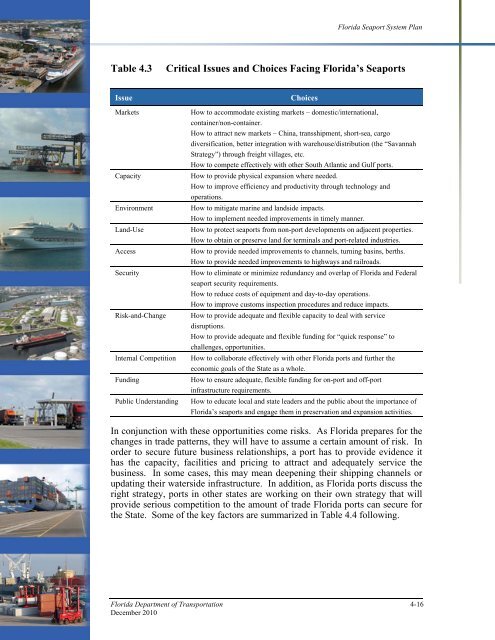Florida Seaport System Plan - SeaCIP
Florida Seaport System Plan - SeaCIP
Florida Seaport System Plan - SeaCIP
You also want an ePaper? Increase the reach of your titles
YUMPU automatically turns print PDFs into web optimized ePapers that Google loves.
<strong>Florida</strong> <strong>Seaport</strong> <strong>System</strong> <strong>Plan</strong><br />
Table 4.3<br />
Critical Issues and Choices Facing <strong>Florida</strong>’s <strong>Seaport</strong>s<br />
Issue<br />
Choices<br />
Markets<br />
Capacity<br />
Environment<br />
Land-Use<br />
Access<br />
Security<br />
Risk-and-Change<br />
Internal Competition<br />
Funding<br />
Public Understanding<br />
How to accommodate existing markets – domestic/international,<br />
container/non-container.<br />
How to attract new markets – China, transshipment, short-sea, cargo<br />
diversification, better integration with warehouse/distribution (the “Savannah<br />
Strategy”) through freight villages, etc.<br />
How to compete effectively with other South Atlantic and Gulf ports.<br />
How to provide physical expansion where needed.<br />
How to improve efficiency and productivity through technology and<br />
operations.<br />
How to mitigate marine and landside impacts.<br />
How to implement needed improvements in timely manner.<br />
How to protect seaports from non-port developments on adjacent properties.<br />
How to obtain or preserve land for terminals and port-related industries.<br />
How to provide needed improvements to channels, turning basins, berths.<br />
How to provide needed improvements to highways and railroads.<br />
How to eliminate or minimize redundancy and overlap of <strong>Florida</strong> and Federal<br />
seaport security requirements.<br />
How to reduce costs of equipment and day-to-day operations.<br />
How to improve customs inspection procedures and reduce impacts.<br />
How to provide adequate and flexible capacity to deal with service<br />
disruptions.<br />
How to provide adequate and flexible funding for “quick response” to<br />
challenges, opportunities.<br />
How to collaborate effectively with other <strong>Florida</strong> ports and further the<br />
economic goals of the State as a whole.<br />
How to ensure adequate, flexible funding for on-port and off-port<br />
infrastructure requirements.<br />
How to educate local and state leaders and the public about the importance of<br />
<strong>Florida</strong>’s seaports and engage them in preservation and expansion activities.<br />
In conjunction with these opportunities come risks. As <strong>Florida</strong> prepares for the<br />
changes in trade patterns, they will have to assume a certain amount of risk. In<br />
order to secure future business relationships, a port has to provide evidence it<br />
has the capacity, facilities and pricing to attract and adequately service the<br />
business. In some cases, this may mean deepening their shipping channels or<br />
updating their waterside infrastructure. In addition, as <strong>Florida</strong> ports discuss the<br />
right strategy, ports in other states are working on their own strategy that will<br />
provide serious competition to the amount of trade <strong>Florida</strong> ports can secure for<br />
the State. Some of the key factors are summarized in Table 4.4 following.<br />
<strong>Florida</strong> Department of Transportation 4-16<br />
December 2010
















